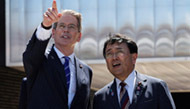The Electoral College

Thomas Jang/ Beckman High School 10th Grade
The number of electoral votes a state has reflects its population. When the country changes in population, the number of electoral votes in each state is affected. If you watched last year’s election, you may have heard newscasters announce each state and its number of electoral votes. That number represents the number of electors in that state. For example, the state of California has 55 electoral votes while the state of New York has 29. On the other hand, large states such as Montana or Nebraska have fewer than five electoral votes. This shows that the sizes of certain states do not clearly reflect their number of electoral votes. The Electoral College’s biased approach in electing a new leader makes it necessary for it to be completely abolished.
To understand the concept of the electing process, it is important to know how it functions. According to The Washington Post, in order for a candidate to be officially elected as president, he or she would need to surpass 270 electoral votes. Each state, including Washington, D.C., has at least three electoral votes because “a state’s number of electors is identical to the total number of its senators and representatives in Congress.” It all adds up to a total of 538 electoral votes.
Ironically, it is actually the votes of the electors (people appointed by the political parties in their states) that will determine the next president, not the vote of the people (the popular vote). In presidential election history, there have only been four times where the winning candidate won the national popular vote but lost the entire election. Additionally, there have been instances where the winner of an election lost the popular vote. First, in 1824, Andrew Jackson won the popular vote but lost the election to John Quincy Adams. Second, in 1876, the most consequential of all presidential elections, Samuel Tilden lost the election despite having had “more popular support” and a narrow vote margin against his opponent, Rutherford B. Hayes.
Third, Grover Cleveland won the popular vote from Benjamin Harrison but lost the election in 1888. Fourth, in 2000, one of the most controversial elections, Al Gore went against George W. Bush. At the end of the election, Bush and Gore were tied. Gore possessed 266 votes compared to Bush’s 246 votes, neither possessing the 270 votes needed for the win. This issue turned into a case that went all the way to the Supreme Court. The issue involved mismatched vote counts in Florida. After two days of intense vote recounting, the Supreme Court awarded Florida’s 25 electoral votes to Bush, which, as a result, allowed him to be “elected” as the next President. Finally, in the most recent election, former Secretary of State Hillary Clinton won the popular vote but lost the election to her opponent, Donald Trump.
Hillary Clinton, the Democratic Party’s nominee in the election, displayed her thoughts on the Electoral College system. “I believe strongly that in a democracy, we should respect the will of the people,” she said. “And to me, that means it’s time to do away with the Electoral College and move to the popular election of our president.” Her stance, along with that of others, has led to local state leaders to present their voices on the issue, such as Jennifer Granholm, a former governor of Michigan. Granholm said, “If we really subscribe to the notion that ‘majority rules,’ then why do we deny the majority of their chosen candidate.” On the other side of the argument, Gary L. Gregg II, Electoral College expert at the University of Louisville, stated that abolishing the system would be a “national nightmare.” Historically, the Electoral College was created “to ensure that that residents in states with smaller populations were not ignored.” Although the system that is used to this day brings many advantages to certain states, its purpose has and is still being taken advantage of. Electors were appointed in their states to “make intelligent choices” for average Americans who “would lack enough information.”
The Electoral College states that it represents each state fairly, but it does not fulfill the purpose it was created for. As Huffington Post explains it, the Electoral College has made “the value of each citizen’s vote different from that of someone living in another state.” Additionally, this signifies that the distribution of electoral votes per state is not equally dispersed. The Electoral College’s objective when it was first created was to make the states feel equally represented in a federalist government.
As Jonathan Mahler and Steve Eder explain in their article “The Electoral College Is Hated By Many,” “The Electoral College is a relic that violates the democratic principles of one person, one vote, and distorts the presidential campaign by encouraging candidates to campaign only in the relatively small number of contested states.”
In order for the Electoral College to be abolished, however, a constitutional amendment is required. Now that Republicans currently control both houses of Congress, the chances of that are unlikely. However, there is a different solution. Instead of completely abolishing the Electoral College, future presidential elections can turn to the National Popular Vote Interstate Compact. As Tyler Lewis, a journalist from Huffington Post, states in his article, “when we vote for President we would actually be voting for President, not instructing ‘electors’ on how we want them to vote.”
The Electoral College is an unfair and skewed system that does not represent citizens’ votes in presidential elections. Now that its flaws have been revealed four times in modern United States history, it defeats the purpose to “equally” represent people’s voices. The system’s unfair and inaccurate representation of how many people voted for a particular candidate has urged people to call for its abolition. In the near future, the United States government will hopefully allow elections to adopt the popular vote. With the popular vote, the elections would present accurate and unbiased data in each state and a candidate’s total amount of votes he or she gains. Although the Electoral College is a significant part of the United States government and its history, its abolition should be accounted for and looked upon by the people and the government of the United States.
<Thomas Jang/ Beckman High School 10th Grade>
스마터리빙
more [ 건강]
[ 건강]이제 혈관 건강도 챙기자!
[현대해운]우리 눈에 보이지 않기 때문에 혈관 건강을 챙기는 것은 결코 쉽지 않은데요. 여러분은 혈관 건강을 유지하기 위해 어떤 노력을 하시나요?
 [ 건강]
[ 건강]내 몸이 건강해지는 과일궁합
 [ 라이프]
[ 라이프]벌레야 물럿거라! 천연 해충제 만들기
 [ 건강]
[ 건강]혈압 낮추는데 좋은 식품
[현대해운]혈관 건강은 주로 노화가 진행되면서 지켜야 할 문제라고 인식되어 왔습니다. 최근 생활 패턴과 식생활의 변화로 혈관의 노화 진행이 빨라지고
사람·사람들
more
[송년행사 화보] “이웃과 함께 나누고 지인과 함께하니 행복”
KYCC13일 윌튼 플레이스 초등학교에서 열린 ‘한인타운청소년회관(KYCC) 홀리데이 카니발’이 성황리에 막을 내렸다. 올해는 KYCC 창립 …

[송년행사 화보] “ ‘손에 손잡고’ 한 해 마무리… 건강과 행복 기원”
전주고·북중남가주 전주고·북중 총동창회(회장 백규종)의 2025년 정기총회 및 송년회가 지난 14일 LA 작가의 집에서 성황리에 열렸다. 이날…
[송년행사 화보] “한 해를 마무리하며… 화기애애…
LA 러너스클럽LA 러너스클럽(회장 김두병)은 13일 작가의 집에서 80여명의 회원과 가족이 참석한 가운데 송년회를 마쳤다. 2007년 창립된…
[송년행사 화보] “웃음과 감사 가득 ‘훈훈’… …
한국학교총연합회미주한국학교총연합회(회장 이영숙)가 주최한 제43회 장기 근속교사 포상 및 송년의 밤 행사가 140여명의 교사들이 참석한 가운데…
[송년행사 화보] “친구야 반갑다… 선배님들 모두…
경남중고경남중·고등학교 남가주 동창회(회장 예해덕)는 지난 6일 송년회를 열고 동문 및 가족 60여 명이 참석한 가운데 끈끈한 우정을 확인했다…
많이 본 기사
- 위기의 트럼프 “내년봄 최대규모 세금… 1
- 백악관, ‘인플레둔화’ 지표에 반색… “바이든 위기와 극명 대비”
- 67명 숨진 워싱턴 여객기·軍헬기 충돌에 정부 ‘책임 인정’
- 尹, 계엄군 장성들에 “미안”…계엄엔… 1
- 韓국방부 “美와 핵잠수함 연료공급 협상 2년 내 완료 목표”
- 美, ‘네타냐후 체포영장·조사’ 국제형사재판소 판사 제재
- 독이 된 박나래 영상..문장 끝 꾹 닫힌 입까지 분석 “리스크 관리 최대”
- “왜 한국 자산 미국으로 옮겨야 하나… 1
- 경찰, 통일교 자금줄 쥔 한학자 前비서실장 13시간 조사
- ‘라도♥’ 에이핑크 윤보미, 손편지로 결혼 발표..9년 열애 결실 “함께하기로”
- 노스캐롤라이나주 공항서 商用항공기 추락…”복수의 사망자”
- 변정수, 갑상선암→성대결절 고백 “거의 죽음을 경험했다”
- 어느덧 20주년.. ‘5남매 가족’ 이동국♥이수진, 세월 잊은 비주얼
- 엡스타인 ‘공범’ 옛 연인 “공정한 재판 못받았다” 석방요구 청원
- 내년 봄 새 앨범→대규모 월드투어..방탄소년단, 완전체 컴백 앞두고 글로벌 음악시장 ‘놀라운 영향력’
- ‘무려 94.2%’ 안세영 새 역사 썼다, 역대 단일 시즌 ‘女 최고 승률’
- LA 소파이 스테디엄 8경기 확정
- 브라운대 한인학생, 총격참사 극적 생존
- “판공비 1만달러 전액 반환하겠다” 3
- 중고차 주행거리 조작 ‘주의보’
- “김혜성만큼은 받지 않을까” 송성문 포스팅 D-3, ML 스카우트도 낙관했다
- “지역 도장과 협동 강화하겠다”
- 구글-메타, 엔비디아 독주 막으려 ‘오월동주’…AI칩 SW개발 협력
- “금리 대폭인하 신봉자”…트럼프가 곧 낙점할 연준 차기의장 누구
- 하원, ‘트럼프 베네수엘라 군사작전 저지 결의’ 무산
- ‘이건희 컬렉션’ 첫 해외 전시에 1만5천명 다녀가… ‘뮷즈’ 완판
- 워싱턴 일원 소비 확 줄어들었다
- 크리스마스 연휴 겨울폭풍 남가주 연안 2~4인치 비
- “보이스피싱 이렇게 당한다”
- 에어 프레미아 취항, 기대 컸나
- 월드컵 방문객 ‘미국행’… 한국선 ESTA(전자 여행 허가서)로 입국 가능
- ‘브라운대 총기참사’ 뉴욕 한인학생도 총상
- 미일, ‘日 5천500억 달러 대미… 1
- 도난 방지 보호장치 무상 제공
- 뱅크오브호프, 규모도 1위·봉사활동도 ‘으뜸’
- 설날, 공립학교 휴일 되나?
- 올해 앵커 재산세 환급 163만명에 18억달러 지급
- LA산불 여파 ‘심각’ 지역 주민 건강악화
- [윌셔에서] 잠시 멈추어 서서
- 미 북서부는 홍수, 동부는 폭설 사태 비상
- 치솟는 원·달러 환율… 1,480원대 찍어
- 컨설팅 제왕 맥킨지 수천명 감원 칼바람
- 강경화 주미대사 신임장 제정 트럼프,… 1
- 박나래 빠진 ‘나혼산’ 촬영 현장 어땠나.. “웃음 보장 100% 조합”
- 5년 규칙은 옛말… 집 사고 10년은 보유해야 본전
- 버지니아 주하원 11지구 민주당 경선
- 북가주 CBMC 송년 감사예배
- “AI 활용 한국어 수업, 선택 아닌 필수”
- ‘천의 얼굴’ 루푸스… “젊은 여성, 이유 없는 발진·탈모 있으면 의심해야”
- 소피아 김의 ‘독보적인 영어 대화법’
1/5지식톡

-
 ☝️해외에서도 가능한 한국어 선생님…
0
☝️해외에서도 가능한 한국어 선생님…
0이 영상 하나면 충분합니다!♥️상담신청문의♥️☝️ 문의 폭주로 '선착순 상담'만 진행합니다.☎️ : 02-6213-9094✨카카오톡ID : @GOODEDU77 (@골뱅이 꼭 붙여주셔야합니다…
-
 테슬라 자동차 시트커버 장착
0
테슬라 자동차 시트커버 장착
0테슬라 시트커버, 사놓고 아직 못 씌우셨죠?장착이 생각보다 쉽지 않습니다.20년 경력 전문가에게 맡기세요 — 깔끔하고 딱 맞게 장착해드립니다!장착비용:앞좌석: $40뒷좌석: $60앞·뒷좌석 …
-
 식당용 부탄가스
0
식당용 부탄가스
0식당용 부탄가스 홀세일 합니다 로스앤젤레스 다운타운 픽업 가능 안녕 하세요?강아지 & 고양이 모든 애완동물 / 반려동물 식품 & 모든 애완동물/반려동물 관련 제품들 전문적으로 홀세일/취급하는 회사 입니다 100% …
-
 ACSL 국제 컴퓨터 과학 대회, …
0
ACSL 국제 컴퓨터 과학 대회, …
0웹사이트 : www.eduspot.co.kr 카카오톡 상담하기 : https://pf.kakao.com/_BEQWxb블로그 : https://blog.naver.com/eduspotmain안녕하세요, 에듀스팟입니다…
-
 바디프렌드 안마의자 창고 리퍼브 세…
0
바디프렌드 안마의자 창고 리퍼브 세…
0거의 새제품급 리퍼브 안마의자 대방출 한다고 합니다!8월 23일(토)…24일(일) 단 이틀!특가 판매가Famille: $500 ~ $1,000Falcon: $1,500 ~ $2,500픽업 & 배송직접 픽업 가능LA…
케이타운 1번가
오피니언
 수잔 최 한미가정상담소 이사장 가정법 전문 변호사
수잔 최 한미가정상담소 이사장 가정법 전문 변호사 [수잔 최 변호사의 LIFE &] AI 시대 편리함에 안주하지 말자
 김도년 성균관대 건축학과 교수 스마트도시·건축학회장
김도년 성균관대 건축학과 교수 스마트도시·건축학회장 [로터리] 지멘스가 만드는 미래 동네

[여명] 금붕어를 키우는 오지선다형 수능
 허경옥 수필가
허경옥 수필가 [윌셔에서] 잠시 멈추어 서서
 양홍주 / 한국일보 논설위원
양홍주 / 한국일보 논설위원[지평선] 판다 없는 일본

[왈가 왈부] 쿠팡 김범석 “글로벌 CEO라 불출석”… ‘맹탕’ 청문회 불보듯
 정숙희 논설위원
정숙희 논설위원칠레에서 영국까지, 27년을 걷다
 마크 A. 시쎈 / 워싱턴포스트 칼럼니스트
마크 A. 시쎈 / 워싱턴포스트 칼럼니스트 [마크 A. 시쎈 칼럼] MAGA와 ‘힘에 바탕한 외교정책’
 김동찬 시민참여센터 대표
김동찬 시민참여센터 대표 [미국은 지금] 위기의 시대, 사회안전망은 최후의 방어선이다
1/3지사별 뉴스

‘브라운대 총기참사’ 뉴욕 한인학생도 총상
▶총상 입은 상황서도 동료학생 의식 잃지않도록 도와 ▶부친도 동문 “우리 가족에게 고통스러운 일”지난 13일 발생한 브라운대학교 총기난사(본보…
뉴욕주 안락사 합법화 초읽기 호쿨, “안전장치 마련되면 서명”

워싱턴 일원 소비 확 줄어들었다
올해 8월 워싱턴DC에 범죄와의 전쟁을 명분으로 주방위군이 본격적으로 배치된 가운데, 이 시기 이후부터 버지니아와 메릴랜드, DC 등 워싱턴 …
“북VA 주택시장 가격 급등 없다”

베이지역 스포츠팀, SF 한인회에 후원금
샌프란시스코 베이지역 한인회(회장 김한일)는 한인 메이저리거 이정후 선수의 소속팀인 샌프란시스코 자이언츠(San Francisco Giants…
불자커뮤니티 20일 청소년발표회및 송년회

오늘 하루 이 창 열지 않음 닫기 



















































.png)


댓글 안에 당신의 성숙함도 담아 주세요.
'오늘의 한마디'는 기사에 대하여 자신의 생각을 말하고 남의 생각을 들으며 서로 다양한 의견을 나누는 공간입니다. 그러나 간혹 불건전한 내용을 올리시는 분들이 계셔서 건전한 인터넷문화 정착을 위해 아래와 같은 운영원칙을 적용합니다.
자체 모니터링을 통해 아래에 해당하는 내용이 포함된 댓글이 발견되면 예고없이 삭제 조치를 하겠습니다.
불건전한 댓글을 올리거나, 이름에 비속어 및 상대방의 불쾌감을 주는 단어를 사용, 유명인 또는 특정 일반인을 사칭하는 경우 이용에 대한 차단 제재를 받을 수 있습니다. 차단될 경우, 일주일간 댓글을 달수 없게 됩니다.
명예훼손, 개인정보 유출, 욕설 등 법률에 위반되는 댓글은 관계 법령에 의거 민형사상 처벌을 받을 수 있으니 이용에 주의를 부탁드립니다.
Close
x